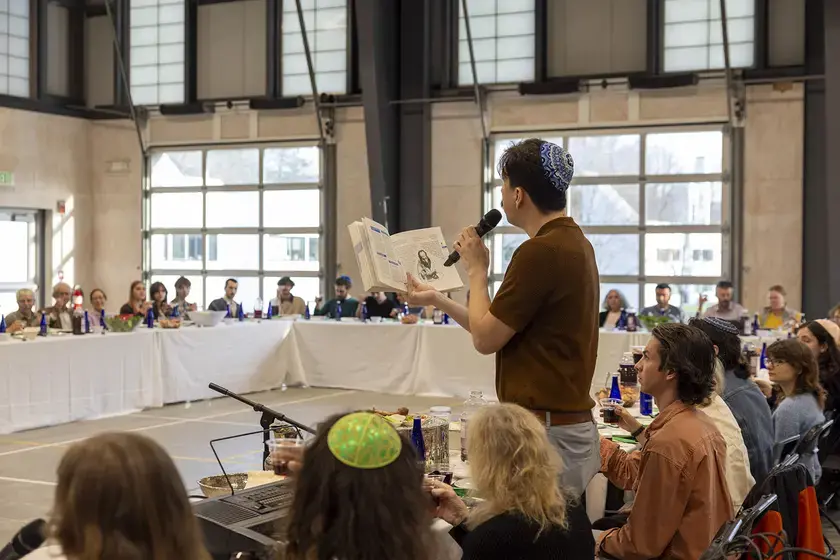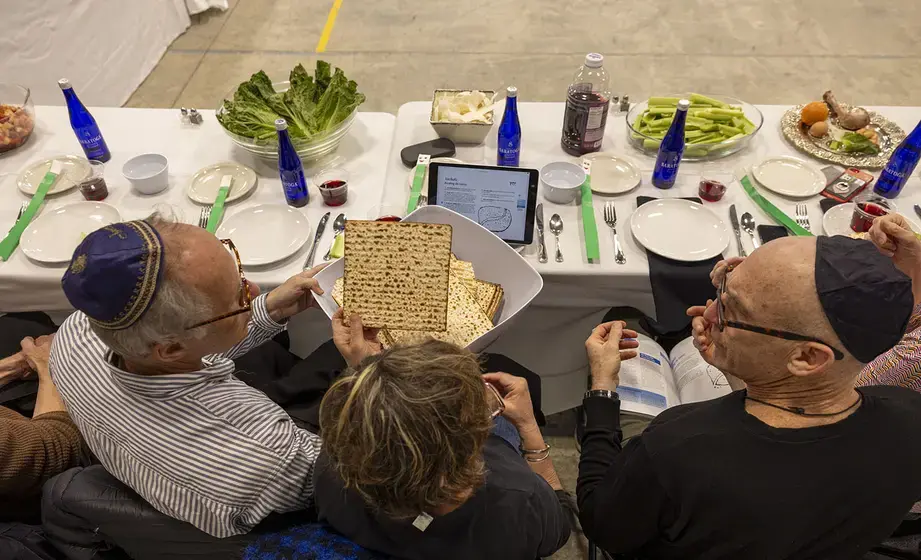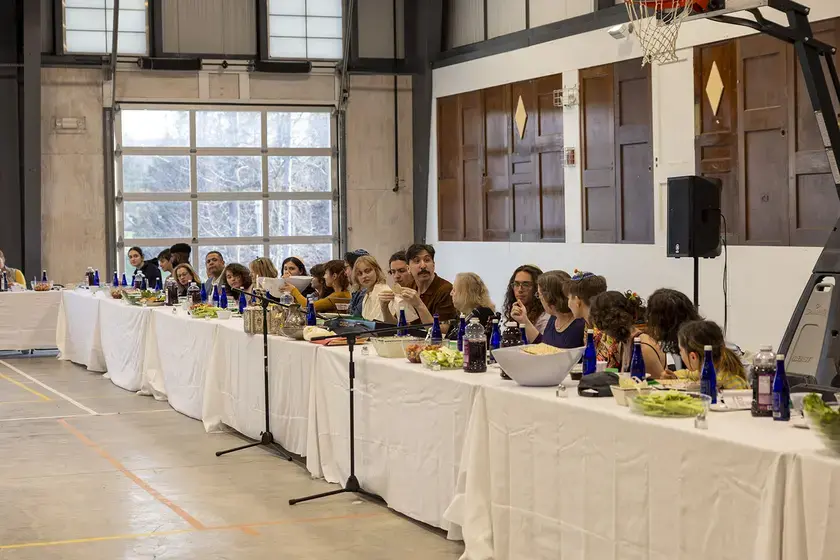Bennington Answers “How Do We Celebrate Passover This Year?”
On Tuesday, April 23, around ninety Jewish and non-Jewish people from every constituency—students, faculty, staff, administration, members of local Jewish congregations, and community members—gathered in the Student Center and took seats around a gigantic ring of white-clothed tables with careful place settings for a Passover Seder.
A Hard Year to Celebrate
After music faculty member and seder leader Joseph Alpar thanked the many people and departments involved in making the seder possible, Rabbi Jarah Greenfield gave some opening remarks. Greenfield is the director of youth and family learning at Congregation Beth Israel in North Adams, Massachusetts, and a co-founder of NEFESH, a local group of Jewish families. Her first words came in the form of a question. “How do we celebrate Passover this year?” she asked. She summarized the conflicts far and near and acknowledged that the “infighting and the outfighting has caused many of us to lose our grounding and our ability to work towards a peaceful and just existence for Israel and Palestine.”
Rabbi Greenfield urged listeners to connect Jewish history with the current moment to find the “urgent spiritual messages that Passover has to teach us this year.” She continued, “In celebrating Passover tonight, we cannot bypass or ignore this polarization and this hostility…. The invitation this Passover is to remain aware and open to the complexity of the situation and how tied up Jewish, Palestinian, Israeli, Arab, Muslim, and Christian lives, all our lives, are; to expand our capacity for empathy and compassion; and to experience the hope and joy that is inherent in this crucial endeavor of Passover, a holiday that moves us from slavery to freedom.”
Acknowledging Religious Identities
Hebrew songs, some mournful, some joyous, were sung from the Haggadah, the traditional text recited at the Passover Seder, which was shared among the attendees, or sung from memory. Attendees held glasses of grape juice, a stand in for wine, and drank reverently. Traditional symbolic foods like karpas (green vegetables dipped in saltwater), matzah (unleavened bread), and maror (horseradish or romaine) were passed and eaten. Explanations were provided for the uninitiated. New and old prayers in English and Hebrew punctuated the eating and singing.
The scene was a departure from campus life in the memories of the alumni in attendance. To many, acknowledging one’s own religious beliefs while at Bennington had been taboo.
Brenda Alpar ’62, who is music faculty member Joseph Alpar’s mother and who accompanied the music for the seder on the keyboard, shared that there was a very large Jewish student population, at least a third, when she attended Bennington.
“It didn’t matter if you were Jewish or Christian,” she said. “People were afraid of any kind of criticism or discrimination, so there was an unwritten rule: no religion. I didn’t even know there was a synagogue in Bennington when I was a student here.”
“It just wasn’t the way to be liberal,” corroborated Shira Sternberg Kol ’05 of her time at Bennington. Kol did much of the organizing and connecting to make the seder possible. She added, “When I saw that they did a seder two years ago, I was floored.”
Rojay Bryan ’22, the Assistant Director of Diversity, Equity and Inclusion, who applied for and received grant funding from the Harold Grinspoon Foundation and helped organize this year’s Passover Seder, recounted the vibe during his first year as a student.
“If you came out as any religious identity publically, people would be like, ‘what are you talking about? You’re at Bennington. This is not a religious space.’ It was antithetical to Bennington to be religious in any way, really, but I am happy we get to have a space like this for our students to celebrate all parts of their identity,” he said.



Updating Tradition
The tables were laden with bowls of matzah. The biblical narrative relates how the Israelites left Egypt in such haste that they could not wait for their bread dough to rise. The seder plate included familiar symbols, like the zeroah (shank bone) and beitzah (egg). Bitter horseradish is included on the seder plate to represent the taste of slavery.
There were also contemporary symbols on the seder plate. Olives were included to represent the hope for peace. An orange represented the inclusion of women and LGBTQIA+ people.
“We need to continually make more room for people to come together in wholeness,” said Rabbi Greenfield.
That sentiment was appreciated among the attendees.
“I love that Rabbi Jarah brought in other aspects of identity and made this a safe space for everybody,” Bryan.
Kai Schaffer ’25 works with Bryan in the Office of Diversity Equity and Inclusion with the aim to enhance Jewish life on campus. They helped plan the event and also appreciated the additions to the traditional seder.
“I was raised in Reconstructionism, which is Judaism in the modern age,” they said. “That’s what this seder is: welcoming to all and merging the contemporary with what our ancestors have been doing for thousands of years.”
Meeting the Need
The secular character of college campuses is not limited to Bennington. Rabbi Greenfield was raised as a secular Jew but was already yearning for a spiritual life by the time she became a student at Sarah Lawrence College in New York.
“Exceptional colleges offer a venue for students to cultivate a spiritual community and develop a vocabulary to navigate all of the things that are coming up in the late teens and early twenties,” she said. “I think it’s a vital move on the part of the college to recognize spiritual development as integral to both academic and civic development.” In short, she added, “People need this.”
The robust attendance and support are indications of the need and desire to express faith as a part of many layered identities.
“The turnout was great. It was great to see so many new faces I didn’t expect to be here. I am thrilled,” Schaffer said.
The event resonated with Fox Yarden ’26, who goes by Ivo and studies anthropology. He has been missing his family. His grandfather had died before he entered Bennington. His uncle moved to Europe.
“Typically [my family] would have some sort of gathering [for Passover], but I am not sure we still would,” he said. The event made him feel more connected. “I love seeing so many people here.”
A Group Effort
The primary organizers—Joseph Alpar; Bryan; Rabbi Greenfield; Alfredo Medina, Jr., PhD, Vice President for Diversity, Equity, and Inclusion College Diversity Officer; Schaffer; Melissa Smith, Senior Assistant, Office of the President; and Sternberg Kol—showed continual gratitude for the Dining Services team, the Buildings & Grounds team, and others. They lauded the beautiful meal and appreciated the help with setting up the room. Other departments and individuals were thanked for their contributions, including musicians Brenda Alpar and Ruben Whitaker ’24, who played guitar.
“We have such incredible support from the college community,” said Joseph Alpar. “There was a real desire and need. We have so many students who came out for this, and what a meal!”
Bryan, who also participated in creating programs for Ramadan and its associated Iftar and Eid celebrations, hopes for bigger programs for both Jewish and Muslim students next year.
“We are continually learning just how important religious identity is for our students,” said Medina. “It is a wonderful thing to bring students and community members together in celebrations like this. I am so grateful to everyone who made this event possible.”
Rabbi Greenfield was particularly grateful to Medina and Smith.
“Alfredo headed up the planning and was an incredible ally to Jewish students in taking this on,” she said.
Remembering the Difficulty
If appreciation was one constant throughout the program and comments, so was continual remembrance for those who have died and who are suffering in the Middle East now. Prayers included one for the health, safety, and return of Jewish and Israeli hostages.
As a part of the program, Rabbi Greenfield shared one of the traditional Passover refrains: “All who are hungry, come and eat.” She noted the difficulty of this phrase this year with a prayer called “Hungry,” which was written by Rabbi Rachel Barenblat of North Adams, Massachusetts. The prayer acknowledged famine in Gaza, particularly the agony of parents trying to feed their starving children.
Rabbi Greenfield also acknowledged another often-repeated Passover phrase, “Next year in Jerusalem.” She shared that, according to Jewish belief, Jerusalem is not one earthly place but both an earthly place and a heavenly one. The earthly one is complex and fraught and fractured. The heavenly one is the ideal.
“They are not separate,” said Rabbi Greenfield. “Marrying them to each other in our bodies, minds, selves, nations, humanity, is the work and intention of saying that phrase. Let’s make whatever shifts we need to make in our inner lives, whatever changes we need to make in our outer lives, our actions and expressions, to enter the city of peace and wholeness. That’s where Jerusalem is.”
Rabbi Barenblat’s poem ends, “Next year, may all be fed...Next year, may all be safe and free.” To that arose a resounding, “Amen.”